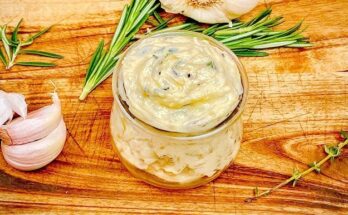Yaki Udon Recipe: Ever been to a Japanese restaurant, ordered a steaming bowl of noodles, and thought, “Wow, I wish I could make this at home”? If so, then you’ve probably met Yaki Udon, the savory stir-fried noodle dish that’s bold, hearty, and downright addictive. Unlike ramen, which is soup-based, Yaki Udon is dry-stirred, bringing together thick udon noodles with a glossy, flavorful sauce, protein, and crisp veggies. And guess what? It’s not nearly as hard to make as it looks.
In fact, with a bit of prep and a good frying pan, you’ll be dishing up your own version in under 30 minutes. Ready to whip up a satisfying, umami-packed dish that’ll rival any takeout? Let’s get started!
What Makes Yaki Udon Special?
First off, it’s the noodles. Udon noodles are thick, chewy, and slurp-worthy, which makes them the perfect base for a stir-fry. They absorb flavor like a sponge but still hold their shape, giving each bite a satisfying chew. Then there’s the sauce — a simple mix of soy sauce, mirin, and sometimes oyster sauce or sesame oil. It’s salty, sweet, and savory all at once.
But what really makes Yaki Udon shine? Its versatility. You can use chicken, beef, pork, tofu, or go all-veggie. Whatever you’ve got in your fridge, you can probably toss it into this dish. It’s that flexible. And best of all? It’s fast — a true weeknight hero.
List of Ingredients You’ll Need
Here’s what you’ll need to get cooking:
Basic Ingredients:
- Udon noodles (fresh or frozen preferred)
- Vegetable oil or sesame oil
- Garlic (minced)
- Onion (sliced thin)
Protein (Pick One or Combine):
- Chicken breast or thighs, sliced thin
- Beef strips
- Shrimp, peeled and deveined
- Firm tofu, cubed
Vegetables (Use a Combo):
- Cabbage (Napa or green)
- Carrots (julienned)
- Bell peppers
- Scallions (for garnish)
- Mushrooms (shiitake, button, or oyster)
For the Sauce:
- 3 tbsp Soy sauce
- 1 tbsp Oyster sauce
- 1 tbsp Mirin or rice wine
- 1 tsp Sugar
- Optional: 1 tsp Sesame oil, chili flakes, or Sriracha
Optional Garnishes:
- Sesame seeds
- Bonito flakes
- Pickled ginger
- Nori strips
Having everything prepped and within arm’s reach makes the cooking process smooth and stress-free.
Choosing the Right Udon Noodles
Now let’s talk noodles, because not all udon is created equal. You’ll find three main types in stores:
1. Fresh Udon Noodles:
These are the real deal — soft, bouncy, and ready to go. You can usually find them vacuum-sealed in the refrigerated or frozen section of Asian markets. They only need a quick rinse in hot water to separate.
2. Frozen Udon:
Almost as good as fresh. They maintain that chewy texture and don’t clump together as much as dried noodles. Plus, they last longer in the freezer.
3. Dried Udon:
This is the pantry staple. It’s fine in a pinch, but they tend to be less chewy and more prone to overcooking. If you use them, rinse well under cold water after boiling to stop the cooking process.
Pro Tip: Always undercook your noodles just slightly since they’ll continue cooking in the pan.
Essential Tools You’ll Need
Before you heat up that wok, make sure you’ve got the right gear.
- Wok or Large Skillet: A non-stick pan works, but a wok is best for high heat and quick stir-frying.
- Sharp Knife: For slicing vegetables and protein evenly.
- Cutting Board: Preferably two — one for meat and one for veggies.
- Mixing Bowls: For prepping sauce and tossing ingredients.
- Tongs or Chopsticks: Helps stir-fry without breaking the noodles.
Having the right tools makes cooking quicker, safer, and more fun.
Prepping the Ingredients
This step is what separates pros from panickers in the kitchen. Mise en place (a fancy way of saying “everything in its place”) will save you serious time.
1. Chop the Veggies:
Cut your carrots into matchsticks, slice onions and peppers thinly, and chop cabbage into bite-size chunks. Mushrooms should be sliced, not too thick.
2. Prep the Protein:
- For chicken or beef, slice thinly against the grain.
- Shrimp should be deveined and patted dry.
- Tofu should be pressed for at least 15 minutes and then cubed.
3. Mix the Sauce:
In a small bowl, whisk together soy sauce, oyster sauce, mirin, sugar, and optional sesame oil or spice. Set it aside for later. This step saves you from fumbling at the stove.
Making the Yaki Udon Sauce
Let’s break down this magical sauce. It’s the soul of the dish.
Basic Sauce Recipe:
- 3 tbsp soy sauce
- 1 tbsp oyster sauce
- 1 tbsp mirin
- 1 tsp sugar
- Optional: 1 tsp sesame oil, ½ tsp chili flakes or Sriracha for heat
Flavor Tips:
- Use low-sodium soy sauce if you’re watching salt intake.
- Mirin adds sweetness and gloss — rice vinegar can sub, but add extra sugar.
- No oyster sauce? Use hoisin sauce or a bit more soy and sugar.
Mix well and taste. You can tweak it based on your preferences: more sweet, more heat, or more umami.
Step-by-Step Cooking Instructions
Ready to get those noodles sizzling? Follow this simple, foolproof process to make a perfect Yaki Udon every time. Don’t worry—it’s fast, fun, and incredibly satisfying.
Step 1: Cook the Udon Noodles
If you’re using fresh or frozen udon noodles, place them in a bowl of hot (not boiling) water for a few minutes until they loosen up. Gently separate them with chopsticks or tongs, then drain and set aside.
If using dried noodles, cook them according to the package instructions. Be sure to undercook by 1 minute since they’ll finish in the pan. After boiling, rinse with cold water to stop the cooking and keep them from getting mushy.
Pro Tip: Toss noodles with a tiny drizzle of oil to keep them from sticking while you prep the rest.
Step 2: Sauté the Protein
Heat 1–2 tablespoons of oil in your wok or large skillet over medium-high heat. Once the pan is hot, add your protein (chicken, beef, shrimp, or tofu). Don’t overcrowd the pan—cook in batches if needed.
Let the protein sear without moving it for 1–2 minutes to get a nice caramelized edge. Then stir and cook until fully done. Remove from the pan and set aside on a plate.
Tip for Tofu: Fry until golden on all sides so it stays firm and doesn’t fall apart when you add sauce later.
Step 3: Add the Vegetables
In the same pan, add a bit more oil if necessary. Toss in your onions and carrots first—they take the longest to soften. After 1–2 minutes, add cabbage, mushrooms, and bell peppers.
Stir-fry over medium-high heat for 3–4 minutes until vegetables are slightly tender but still crisp. You want that bite, not a mushy mess.
Optional Add-in: Add a clove of minced garlic or a teaspoon of grated ginger for extra depth.
Step 4: Combine Noodles and Sauce
Now add the drained udon noodles to the pan with the sautéed vegetables. Gently toss everything together so the noodles don’t break. This is where your wok’s high sides come in handy!
Pour the sauce evenly over the noodles and toss again. The noodles will start to soak up all that glossy, umami goodness. Keep stir-frying everything for 2–3 minutes.
Re-add your cooked protein and mix well so everything is evenly coated and heated through.
Step 5: Stir-Fry to Finish
Turn the heat up just a notch and stir-fry everything for another minute or two. You’re looking for slightly crispy edges on the noodles and a beautiful caramelized finish on the sauce. Taste and adjust—add a splash more soy sauce or mirin if needed.
Once everything is hot, coated, and smelling divine, you’re done!
Final Touch: Remove from heat and top with green onions, sesame seeds, or whatever garnish you love.
Common Variations of Yaki Udon
The beauty of Yaki Udon? It’s endlessly customizable. Here are a few popular variations to try:
Vegetarian Yaki Udon:
Skip the meat and load up on mushrooms, tofu, and leafy greens. Add extra umami with a splash of soy sauce and a touch of miso paste in the sauce.
Spicy Yaki Udon:
Add chili garlic sauce, gochujang, or a big spoonful of Sriracha to your stir-fry. Crushed red pepper flakes work too.
Seafood Yaki Udon:
Use a combo of shrimp, scallops, and squid. Seafood cooks fast—add near the end and cook just until opaque.
Tofu or Tempeh Yaki Udon:
A great plant-based version. Marinate tofu in soy sauce and garlic first, then pan-fry for crispy edges.
Mix and match ingredients based on your cravings or what you’ve got in the fridge.
Tips to Get That Restaurant-Quality Flavor
Want to take your Yaki Udon from good to mind-blowing? Try these pro tips:
- Use high heat. Stir-frying is all about quick, high-temperature cooking. Don’t be afraid to crank up the flame.
- Don’t overcrowd the pan. It causes steaming instead of searing. Cook in batches if your pan is small.
- Add sauce last. If you add it too early, it can burn. Pour it in just as everything is nearly cooked.
- Toss gently. Use tongs or chopsticks to prevent breaking the udon noodles.
- Finish with sesame oil. Just a few drops at the end boost aroma and flavor without overpowering the dish.
It’s all about technique and timing—master these, and your stir-fry will rival your favorite Japanese joint.
Serving Suggestions
Yaki Udon is a full meal in a bowl, but if you’re feeling fancy, pair it with a few simple sides:
Great Pairings:
- Miso soup – Light and warming
- Japanese pickles – Adds crunch and acidity
- Gyoza (dumplings) – A perfect crispy complement
- Edamame – A protein-packed finger food
- Side salad with sesame dressing
Drinks? A cold glass of green tea, sake, or even a light beer pairs perfectly.
Top your bowl with:
- A soft-boiled egg
- Bonito flakes (they dance from the heat!)
- Thinly sliced nori (seaweed)
- A drizzle of Japanese mayo for extra richness
Storage and Reheating Tips
Got leftovers? Lucky you—Yaki Udon makes an awesome next-day meal. Here’s how to store and reheat without losing texture:
Storage:
- Let it cool completely.
- Transfer to an airtight container.
- Store in the fridge for up to 3 days.
Reheating:
- Stovetop: Heat in a non-stick skillet with a splash of water or soy sauce. Stir frequently.
- Microwave: Use a microwave-safe dish, cover loosely, and heat in 30-second intervals. Stir between each round.
Avoid freezing—noodles tend to get mushy and break apart when thawed.
Healthier Yaki Udon Options
Craving Yaki Udon but watching your health? No worries! With a few tweaks, this dish can be surprisingly wholesome.
Health Swaps:
- Use whole-wheat or low-carb noodles.
- Reduce sodium: Use low-sodium soy sauce and skip oyster sauce.
- More veggies, less oil: Bulk up your dish with more cabbage, carrots, and mushrooms.
- Lean protein: Choose chicken breast, shrimp, or tofu instead of fatty cuts of meat.
And remember, homemade is always healthier than takeout—you control every ingredient.
Troubleshooting Common Mistakes
Even the best cooks hit a snag. Here’s how to fix common Yaki Udon hiccups:
Soggy Noodles?
- You may have overcooked them. Always undercook by a minute before stir-frying.
- Rinse boiled noodles under cold water to stop the cooking.
Sauce Too Salty?
- Add a splash of water or unsalted broth to dilute.
- Next time, use low-sodium soy sauce.
Bland Flavor?
- Check your sauce ratios.
- Try adding garlic, sesame oil, or a pinch of MSG (yes, it’s safe in moderation).
Sticky Pan?
- Make sure your pan is properly preheated.
- Use enough oil or switch to a non-stick surface.
FAQs about Yaki Udon Recipe
1. Can I use spaghetti instead of udon?
Yes, but the texture will be different. Spaghetti is thinner and doesn’t have that chewy bite. Try to find fresh or frozen udon for the best experience.
2. Is Yaki Udon spicy?
Not by default, but you can easily make it spicy by adding chili sauce, Sriracha, or red pepper flakes.
3. Can I meal prep Yaki Udon?
Absolutely! It stores well in the fridge and reheats beautifully. Just don’t freeze it.
4. What kind of soy sauce should I use?
Light soy sauce is the standard. Avoid dark soy—it’s too strong and sweet. Use low-sodium if you’re watching your salt intake.
5. Can I freeze Yaki Udon?
It’s not recommended. The noodles tend to become mushy and the sauce separates. Stick to refrigeration for best results.
Final Thoughts
Yaki Udon is one of those dishes that delivers on every front—flavor, texture, and simplicity. With chewy noodles, bold sauce, and a rainbow of veggies, it’s both satisfying and comforting. Once you master this recipe, you’ll find yourself reaching for it on busy weeknights, lazy Sundays, or whenever that takeout craving hits.
Plus, it’s so easy to make your own. Throw in your favorite ingredients, spice it up or keep it mild, and make it your signature dish. Just remember—cook with confidence, taste often, and don’t be afraid to make it your own.
Happy cooking!



